5 Ultracontemporary Artists Redefining the Korean Art Landscape
The dynamic South Korean art scene is quickly becoming one of the most prominent globally, blending rich traditions with cutting-edge innovation. And...
Carlotta Mazzoli 13 January 2025
Rather unsettling, quite macabre, and more than slightly erotic, the paintings and illustrations by Polish artist Aleksandra Waliszewska are definitely one of a kind. Here is our small introduction to Waliszewska’s morbid world and the most common themes in her art.
Aleksandra Waliszewska was born in 1976 in Warsaw. Upon graduating the city’s Academy of Fine Arts, she quickly became one of the most recognized contemporary painters of the Polish new art scene. Her list of accomplishments contains more than 20 solo exhibitions, an Arco Madrid Grand Prix, the EXIT magazine award, the Polish Ministry of Culture and National Heritage scholarships, cooperation with international artists and art groups, and a short movie inspired by her art.
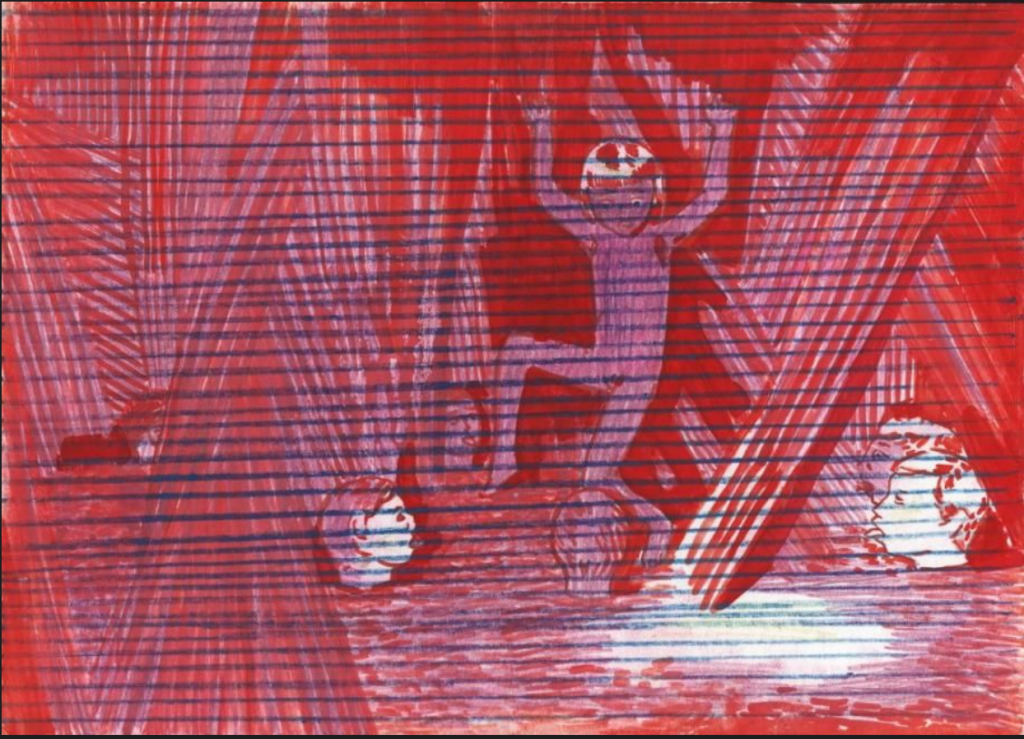
Aleksandra Waliszewska, Dark Forest, CCA Ujazdowski Castle, Warsaw, Poland.
Among the Warsaw art world, Waliszewska is known for her workaholism. However, it seems to be more of a cathartic process of unleashing imaginary tales onto the canvas surface. As she says herself in an interview for KnockMag:
Every time I paint, I am on the edge of saneness.
Her works are simultaneously subconscious and full of visual culture after images. The works are rarely titled nor explained, leaving the viewer unaided in the mad world of small and big stories of horror.
Some common topics can be discerned – Waliszewska has a clear affinity for fatalistic female figures, violence, nihilism, mermaids, mythological figures, and BDSM. Her universe is also densely populated by cats – quite obviously hellish figures. Truly fecund as an artist, she paints at least one artwork a day, currently focusing on watercolors and gouaches. Most of her works are quickly published on her social media pages, thanks to which she amassed quite an impressive following around the world.
I don’t think in all my time I have seen such a consistently terrifying vision of the subconscious world.
In Praise of Aleksandra Waliszewska, The Vampire’s Wife.
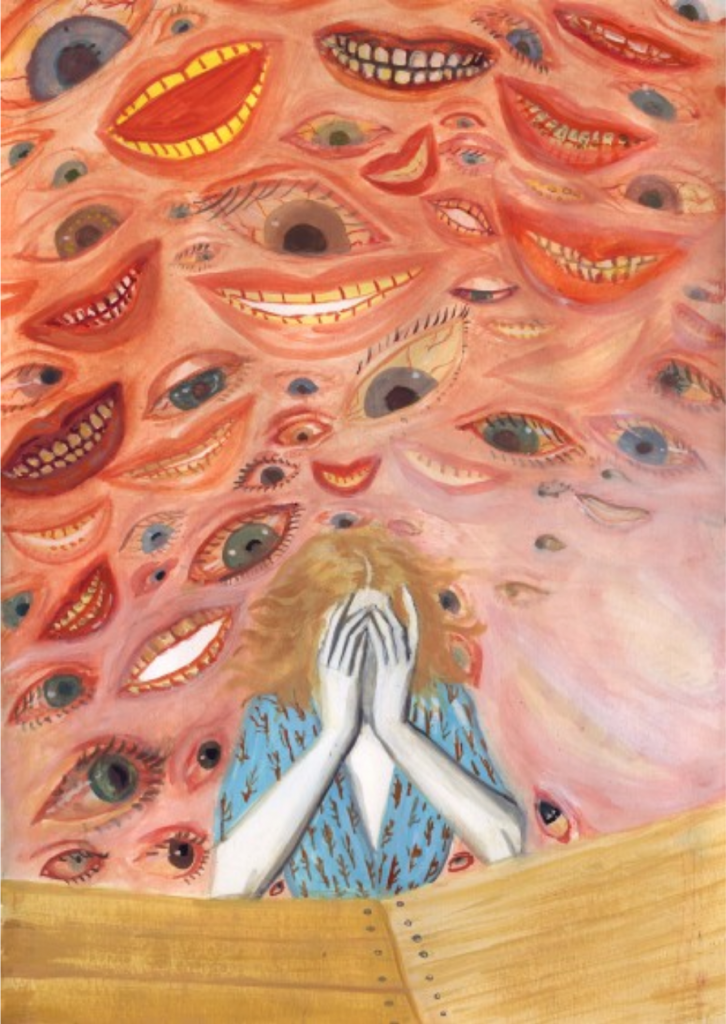
Aleksandra Waliszewska, Untitled, 2020, Museum of Modern Art, Warsaw, Poland.
Because Waliszewska doesn’t title her artworks, it’s up to the viewer to find their own meaning. Paintings and gouaches become mirrors in which we find our own fears and anxieties. Wounds, blood, skulls, and the Grim Reaper himself commonly visit the artist’s studio. These themes often reach into the vast iconography of Death in art history, from Danse Macabre woodcuts to Polish Symbolists’ fear of mortality.
Ghastly creatures are also typically derived from Balto-Slavic mythology, with nightmarish upiór (loosely from Polish: phantom, ghost) at the forefront. However, together with mythological creatures, we find all kinds of monsters – aliens, spiders, phantoms… or little girls. You choose what you fear the most.
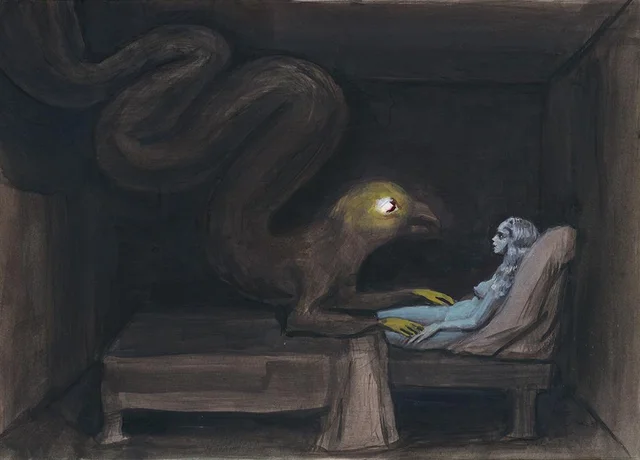
Aleksandra Waliszewska, Untitled, 2019. Courtesy of the artist.
Cats are definitely the artist’s favorite animal. Her late cat, Mitusia, is her biggest muse and source of inspiration. That’s not surprising – cats are not only fantastic models but also one of the primary animals associated with whatever is demonic or hellish. Waliszewska’s cats have a life of their own smoking cigarettes, performing rituals, playing instruments, battling, or just staring right deep into your soul. Or nibbling on your intestines… you know, typical cat things!
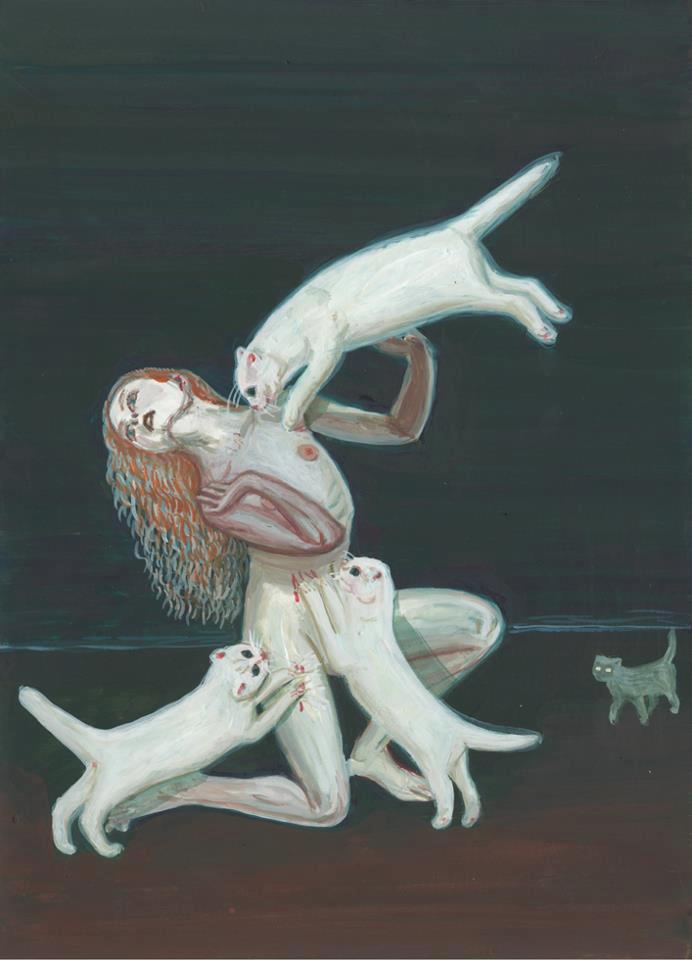
Aleksandra Waliszewska, Untitled, 2011. Courtesy of the artist.
Cats and demons are not the only protagonists in Waliszewska’s gloomy world. Interestingly, she rarely paints male figures, if anything, making them bystanders or perpetrators. Here’s where she cuts ties from her symbolist forebears – whether mermaids, maidens, or madonnas, female protagonists in her works are free of the evil feminine trope and the male gaze. Her heroines are both victims of dreadful scenes of sexual torture, but also violent hunters, innocent and seductive, taking revenge on their abusers.
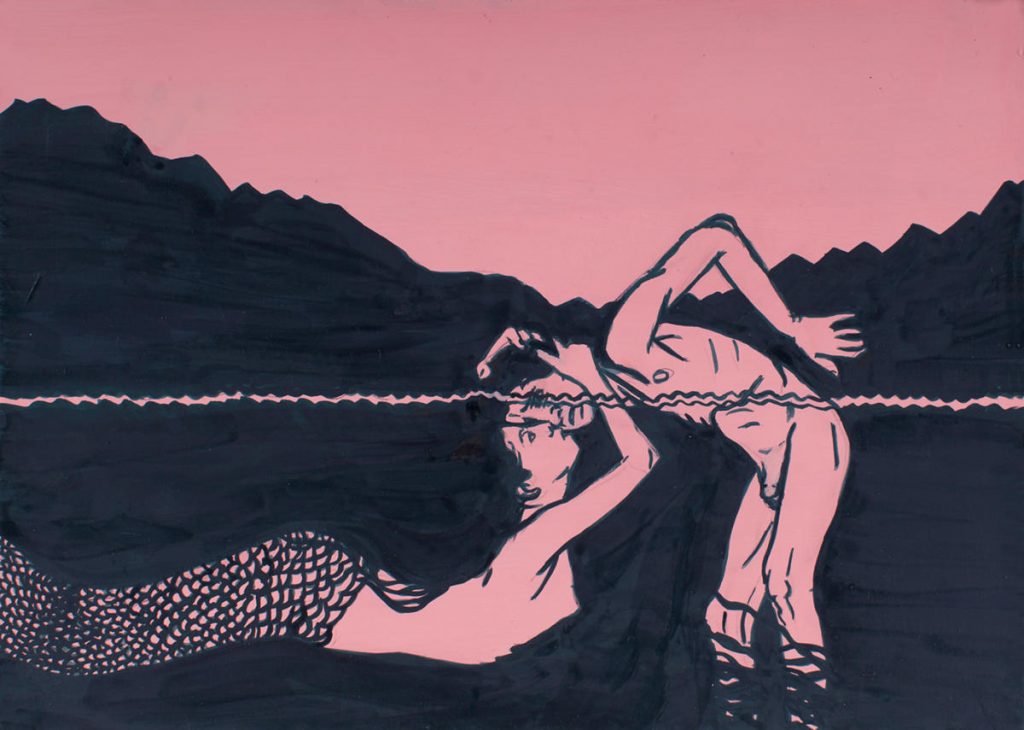
Aleksandra Waliszewska, Untitled, 2008-2016, phot. Bartosz Stawiarski. Courtesy of the artist.
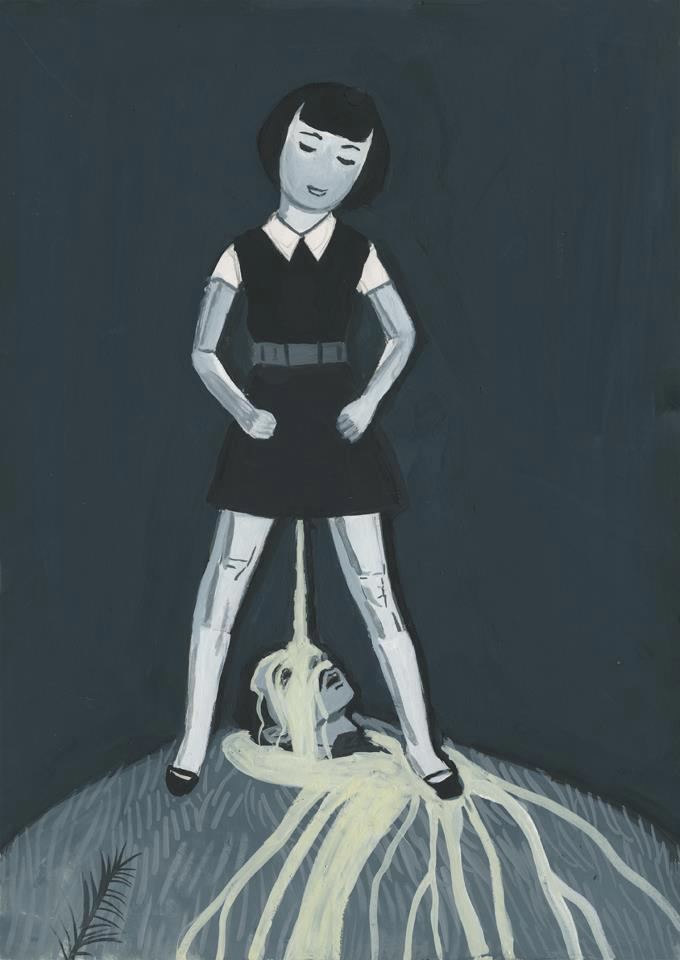
Aleksandra Waliszewska, The Death of the Pedophile. Courtesy of the artist.
The artist’s large social media presence resulted in the quick popularization of her unique style in similarly gloomy artistic genres. Especially worth mentioning are album covers (not surprisingly, mainly heavy metal) and film posters. My personal favorite is the artwork promoting a masterpiece of a movie itself, the international poster for Agnieszka Smoczyńska’s The Lure (2015).
Waliszewska’s drawings also inspired a short art house movie, The Capsule (2012), directed by Athina Rachel Tsangari and co-written by the artist. The film describes itself as a “Greek gothic mystery”, and tells the story of seven young women trying to negotiate the cycle of womanhood. Waliszewska also found her way to fashion, collaborating both with Susie Cave (The Vampire’s Wife) and Joanna Hawrot.

Aleksandra Waliszewska, Untitled, poster for The Lure, 2015, dir. Agnieszka Smoczyńska.
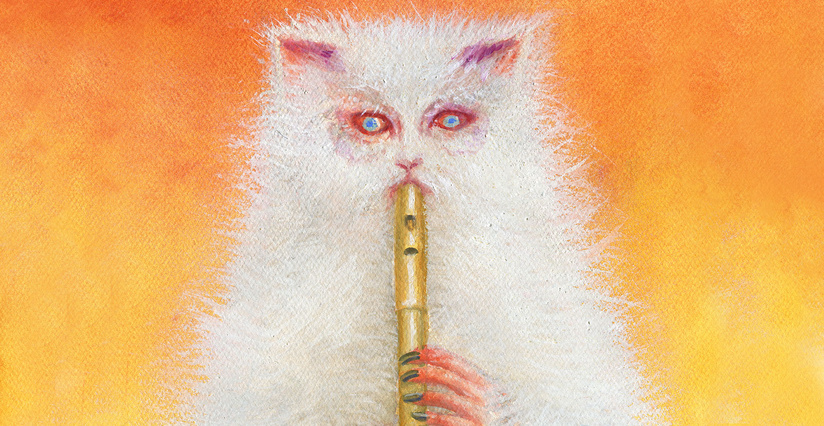
Aleksandra Waliszewska, Untitled, 2020, Museum of Modern Art, Warsaw, Poland.
In 2022 the Museum of Modern Art in Warsaw organized an exhibition of Waliszewska’s works The Dark Arts: Aleksandra Waliszewska and the Symbolism from the East and North. It was the artist’s most extensive display so far. Her works were juxtaposed with historical works by other, mainly symbolist artists. It highlighted one of Waliszewska’s main artistic strengths – her true love for art history. The exhibition itself was a wonder for any fan of the dark and gloomy. It featured impressive works by artists such as Mikalojus Čiurlionis, Bolesław Biegas, Edward Okuń, Kristjan Raud, Maria Anto, and many more.
The exhibition also featured artworks by Waliszewska’s family members – her great-grandmother Kazimiera Dębska, a fairytale writer, her grandmother Anna Dębska – a postwar sculptor with a shared affinity for felines, and the artist’s mother, Joanna Waliszewska.
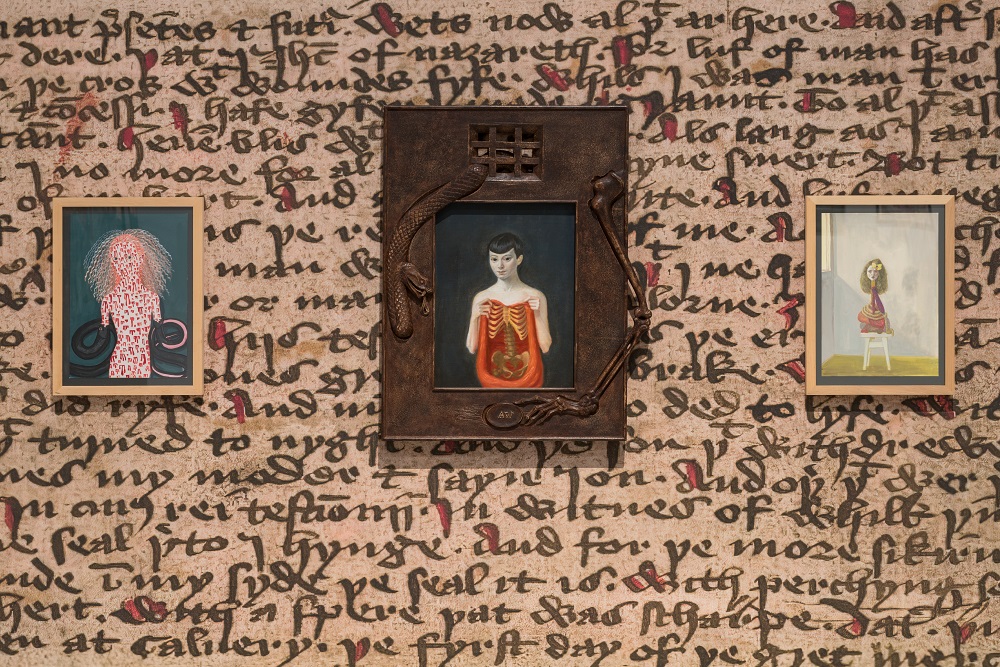
Installation view, The Dark Arts: Aleksandra Waliszewska and the Symbolism from the East and North, 2022, Museum of Modern Art, Warsaw, Poland.
![aleksandra waliszewska: Aleksandra Waliszewska, Untitled [Mitusia], 2018, private collection. Vogue Poland.](https://www.dailyartmagazine.com/wp-content/uploads/2022/09/ce1-1-1024x728-1.jpeg)
Aleksandra Waliszewska, Untitled [Mitusia], 2018, private collection. Vogue Poland.
In Waliszewska’s eerie universe cats roam freely and fatalistic women lurk in the shadows. Viewing her paintings is a journey through a world of violence, nihilism, and BDSM, where mermaids and mythological figures coexist in a surreal landscape. Waliszewska’s art is a reflection of her subconscious mind, drawing on a rich tapestry of visual culture and leaving the viewer to unravel the hidden meanings behind her works. Her unique style and themes have popularized similarly gloomy artistic genres, making her art worth exploring further.
DailyArt Magazine needs your support. Every contribution, however big or small, is very valuable for our future. Thanks to it, we will be able to sustain and grow the Magazine. Thank you for your help!